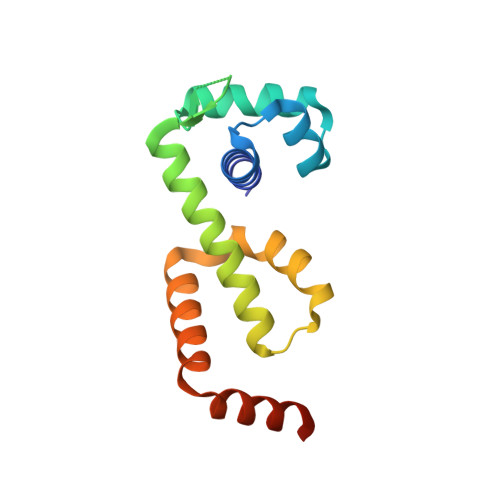Roles of the A and C Sites in the Manganese-Specific Activation of MntR.
McGuire, A.M., Cuthbert, B.J., Ma, Z., Grauer-Gray, K.D., Brunjes Brophy, M., Spear, K.A., Soonsanga, S., Kliegman, J.I., Griner, S.L., Helmann, J.D., Glasfeld, A.(2013) Biochemistry 52: 701-713
- PubMed: 23298157
- DOI: https://doi.org/10.1021/bi301550t
- Primary Citation of Related Structures:
3R60, 3R61, 4HV5, 4HV6, 4HX4, 4HX7, 4HX8 - PubMed Abstract:
The manganese transport regulator (MntR) represses the expression of genes involved in manganese uptake in Bacillus subtilis. It selectively responds to Mn(2+) and Cd(2+) over other divalent metal cations, including Fe(2+), Co(2+), and Zn(2+). Previous work has shown that MntR forms binuclear complexes with Mn(2+) or Cd(2+) at two binding sites, labeled A and C, that are separated by 4.4 Å. Zinc activates MntR poorly and binds only to the A site, forming a mononuclear complex. The difference in metal binding stoichiometry suggested a mechanism for selectivity in MntR. Larger metal cations are strongly activating because they can form the binuclear complex, while smaller metal ions cannot bind with the geometry needed to fully occupy both metal binding sites. To investigate this hypothesis, structures of MntR in complex with two other noncognate metal ions, Fe(2+) and Co(2+), have been determined. Each metal forms a mononuclear complex with MntR with the metal ion bound in the A site, supporting the conclusions drawn from the Zn(2+) complex. Additionally, we investigated two site-specific mutants of MntR, E11K and H77A, that contain substitutions of metal binding residues in the A site. While metal binding in each mutant is significantly altered relative to that of wild-type MntR, both mutants retain activity and selectivity for Mn(2+) in vitro and in vivo. That observation, coupled with previous studies, suggests that the A and C sites both contribute to the selectivity of MntR.
- Department of Chemistry, Reed College, Portland, OR 97202, USA.
Organizational Affiliation:

















